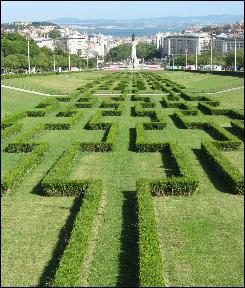Victoria here, writing from Lisbon, where it is sunny and delightfully breezy. Above, the statue of Marquis de Pombal, at the foot of Parque Eduardo VII, named for the British King who visited here in 1903 to confirm the continuing alliance of Portugal and the United Kindom. Below, the view from the top of the park, looking down toward the statue, the broad tree-lined boulevard beyond it, to the River Tagus.
The Marquis de Pombal (1699-1782) was a distinguished statesman who provided strong leadership after the terrible earthquake and tsunami that devastated Lisbon November 1, 1755. He also abolished slavery in Portugal and her colonies, reorganized the army and navy, and improved the administration of colonial Brazil, among other accomplishments. His statue overlooks the Avenida da Liberdade, a broad boulevard with gardens and restaurants and lined by banks, hotels and smart shops.
As one strolls the Avenida, there are wonderful views up the cross streets, which lead into the hilly old town areas, most of which predate the earthquake and survived the floods.
The museum has a huge collection of artillery, from gigantic cannons down to pistols and daggers. In the courtyard, many cannons can be see arranged in front of the story of the Portuguese in beautiful blue-and-white ceramic tiles.

Inside the museum were displays of events from the discovery of sea routes to India by Vasco DaGama through the Napoleonic invasions to World Wars I and II. Below the uniform of Portuguese troops fighting with Lord Wellington early in the Peninsular Wars.












What gorgeous photos! Thanks for taking us along on the trip and who knew there was so much to connect Regency England and Portugal. LOVE those trees. They remind me of my wisteria when it is in full bloom.
ReplyDeletehow lovely, Vicky!!!
ReplyDelete